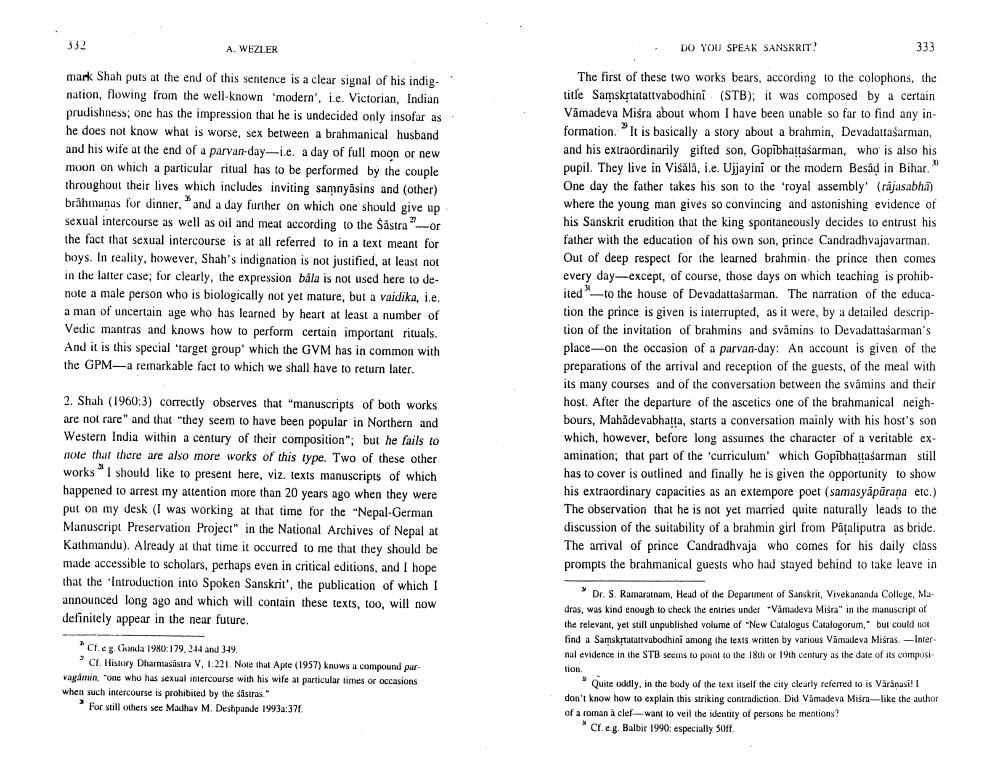________________
332
A. WEZLER
35
mark Shah puts at the end of this sentence is a clear signal of his indignation, flowing from the well-known 'modern', i.e. Victorian, Indian prudishness; one has the impression that he is undecided only insofar as he does not know what is worse, sex between a brahmanical husband and his wife at the end of a parvan-day-i.e. a day of full moon or new moon on which a particular ritual has to be performed by the couple throughout their lives which includes inviting samnyasins and (other) brahmanas for dinner, and a day further on which one should give up sexual intercourse as well as oil and meat according to the Sastra-or the fact that sexual intercourse is at all referred to in a text meant for boys. In reality, however, Shah's indignation is not justified, at least not in the latter case; for clearly, the expression bâla is not used here to denote a male person who is biologically not yet mature, but a vaidika, i.e. a man of uncertain age who has learned by heart at least a number of Vedic mantras and knows how to perform certain important rituals. And it is this special 'target group' which the GVM has in common with the GPM-a remarkable fact to which we shall have to return later.
2. Shah (1960:3) correctly observes that "manuscripts of both works are not rare" and that "they seem to have been popular in Northern and Western India within a century of their composition"; but he fails to note that there are also more works of this type. Two of these other works "I should like to present here, viz. texts manuscripts of which happened to arrest my attention more than 20 years ago when they were put on my desk (I was working at that time for the "Nepal-German Manuscript Preservation Project" in the National Archives of Nepal at Kathmandu). Already at that time it occurred to me that they should be made accessible to scholars, perhaps even in critical editions, and I hope that the 'Introduction into Spoken Sanskrit', the publication of which I announced long ago and which will contain these texts, too, will now definitely appear in the near future.
Cf. eg. Gonda 1980:179, 244 and 349.
* Cf. History Dharmasastra V, 1:221. Note that Apte (1957) knows a compound par vagamin, "one who has sexual intercourse with his wife at particular times or occasions when such intercourse is prohibited by the sastras."
.
For still others see Madhav M. Deshpande 1993a:37f
333
DO YOU SPEAK SANSKRIT?
The first of these two works bears, according to the colophons, the title Samskṛtatattvabodhini (STB); it was composed by a certain Vamadeva Misra about whom I have been unable so far to find any information. It is basically a story about a brahmin, Devadattaŝarman, and his extraordinarily gifted son, Gopībhattaśarman, who is also his pupil. They live in Višălă, i.e. Ujjayini or the modern Besäḍ in Bihar." One day the father takes his son to the 'royal assembly' (rajasabha) where the young man gives so convincing and astonishing evidence of his Sanskrit erudition that the king spontaneously decides to entrust his father with the education of his own son, prince Candradhvajavarman. Out of deep respect for the learned brahmin the prince then comes every day-except, of course, those days on which teaching is prohibited"-to the house of Devadattaŝarman. The narration of the education the prince is given is interrupted, as it were, by a detailed description of the invitation of brahmins and svamins to Devadattasarman's place on the occasion of a parvan-day: An account is given of the preparations of the arrival and reception of the guests, of the meal with its many courses and of the conversation between the svamins and their host. After the departure of the ascetics one of the brahmanical neighbours, Mahadevabhatta, starts a conversation mainly with his host's son which, however, before long assumes the character of a veritable examination; that part of the 'curriculum' which Gopībhattasarman still has to cover is outlined and finally he is given the opportunity to show his extraordinary capacities as an extempore poet (samasyapūraṇa etc.) The observation that he is not yet married quite naturally leads to the discussion of the suitability of a brahmin girl from Pațaliputra as bride. The arrival of prince Candradhvaja who comes for his daily class prompts the brahmanical guests who had stayed behind to take leave in
Dr. S. Ramaratnam, Head of the Department of Sanskrit, Vivekananda College, Madras, was kind enough to check the entries under Vämadeva Misra" in the manuscript of the relevant, yet still unpublished volume of "New Catalogus Catalogorum," but could not find a Samskṛtatattvabodhini among the texts written by various Vamadeva Mišras. -Internal evidence in the STB seems to point to the 18th or 19th century as the date of its composi
tion.
Quite oddly, in the body of the text itself the city clearly referred to is Värāṇasi! I don't know how to explain this striking contradiction. Did Vämadeva Misra-like the author of a roman à clef want to veil the identity of persons he mentions? 34 Cf. e.g. Balbir 1990: especially 50ff.




